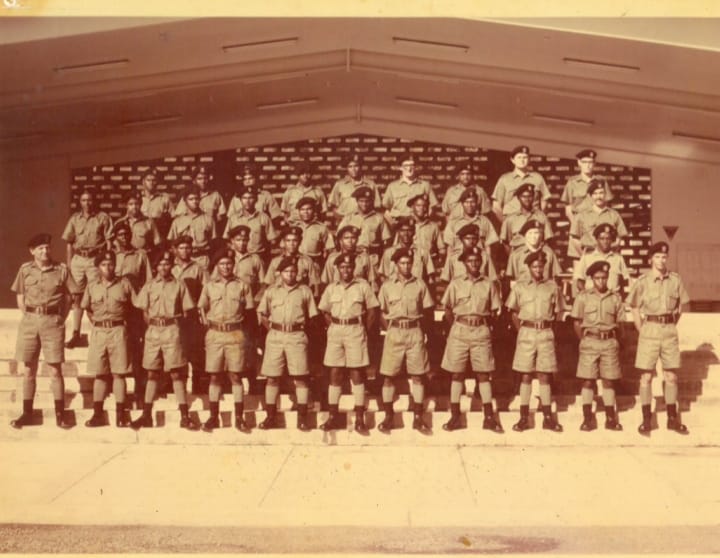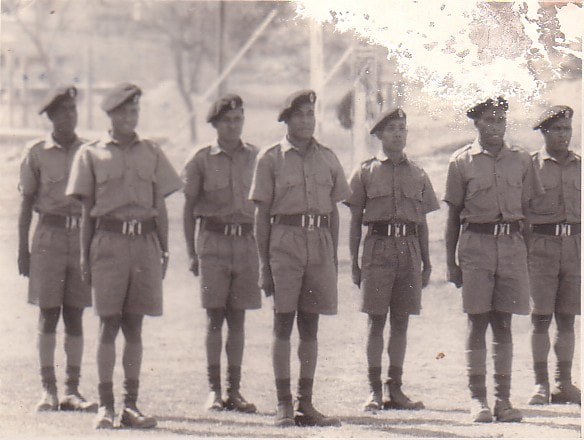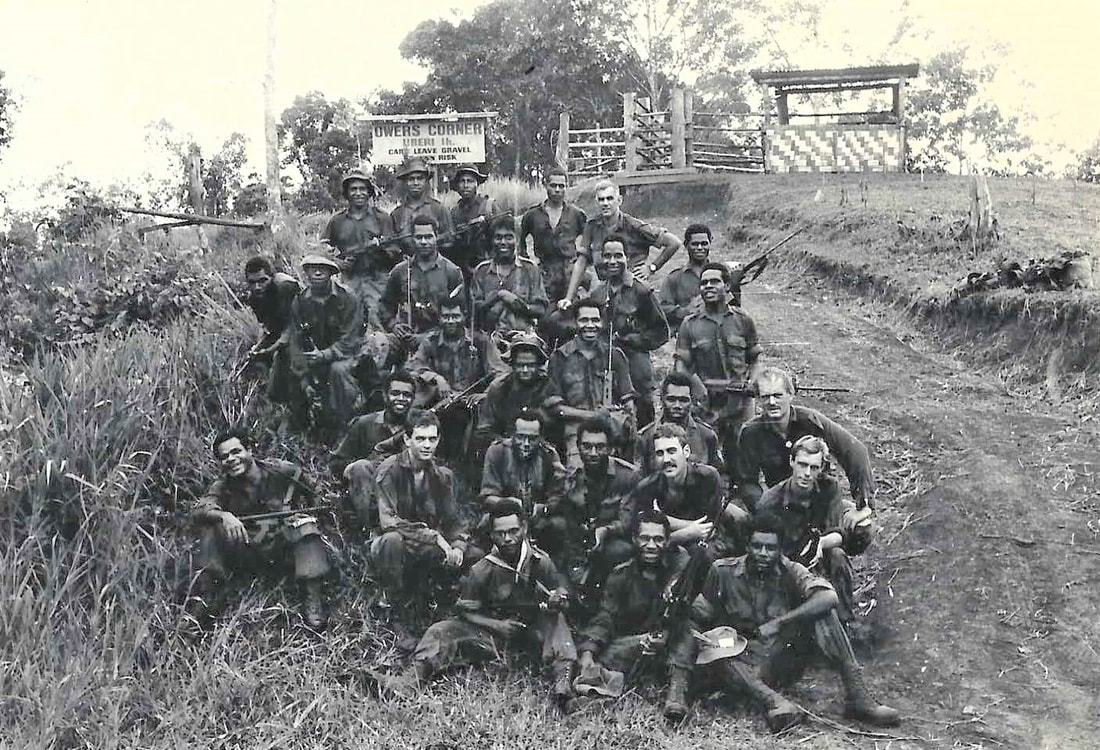University Platoon
In April 1966, Brig AL McDonald, Commander PNG Command, held talks with Dr JT Gunther, the Vice Chancellor of the University of Papua New Guinea on the matter of raising a university regiment, with the initial proposal to raise a platoon which would be later expanded to a company and be administered and commanded by the PNGVR. Recruiting was to commence in 1966 of a platoon of one officer and forty other ranks, with a view to expanding to a company of 5 officers and 100 other ranks when an Army training depot was built on the university site at Waigaíni, either in 1968 or 1969.
The first platoon, designated the University Platoon, PNGVR, was raised in June, with the members coming from administrative college and university students. The first OC was Captain Ken Marshall and the first ARA Instructor was W02 John Boughton who also was posted as Instructor to Administrative and Support Companies of PNGVR.
Some difficulties arose with the University Platoon at Port Moresby because of the combined Administrative College/University makeup of the platoon, in that the term breaks of the two institutions did not coincide and the Administrative College members were not available for the end of the year camp because they had to return to their Public Service Department. Furthermore, the university was not able to change its semester dates because it had adopted the same calendar as Australian universities in order to allow free exchange of staff and students. However, some Administrative College students attended the PNGVR annual camp at Lae in September 1967 and the remainder of the university students attended a special camp at the Goldie River training area. On the positive side, the sub-unit had paraded at Murray Barracks on Thursday evenings throughout the year on three-hour parades and had also attended a number of weekend bivouacs. Forty-eight recruits had been taken on strength at the formation of the sub-unit in June 1966.
1968. In October, tenders were let for the construction of a $125,000 training depot at the university at Port Moresby. The depot included a drill hall, quartermaster’s store (Q store), Officers’ and Sergeants’ Messes, a lecture room and administration officers. The inclusion of two messes drew criticism within PNGVR as being extravagant, nevertheless, they were built. The parade ground was lit by floodlight for night parades. Although the majority of the university staff were not keen on having a military unit on site, the new depot was officially opened in April by the Vice Chancellor John Gunther.
1969. Lt Mike Griffin took the University Pl to Annual Camp at the Goldie River Training area. He later declared that the level of training achieved was of a very high standard. A number of members were students were Trainee Magistrates and several were from the British Solomon Islands Protectorate. General Vickery, the CMF member of the military Board was most impressed with the platoon on his visit to Murray Barracks prior to the Camp.
The University Platoon was still having teething problems, albeit in its third year of operation. Lieutenant Dick Smith became the fourth platoon commander, replacing Lieutenant Mike Griffin. Smith was starting with a small core of NCOs from the 1968 NCO course; he was anxious to ‘rebuild' the sub-unit. In effect, a rebuild had occurred at the beginning of each year. As a result of the review of the University Platoon, put in place by the CO, which included CM F recruitment during the next five years, Harrington produced a report, 'Proposed University Unit in PNG Command’. On future expansion, the report indicated the sub-unit would generally be in accordance with the following pattern:
1969-70: one platoon
1972-73: one company
1970-71: two platoons 1973-74: one company
1971-72: one company
1970
Parade attendances at the University Platoon in Port Moresby had fallen and Major Bob Bowmer had advised the CO that attendance at the sub-unit’s annual camp at the end of the year could be as low as 20. Bob Bowmer said he was aware that in past years attendance at annual camps by university members had been very poor.
HQ PNG Planning Cell stated that their studies were not advanced sufficiently to enable further consideration of the matter of the future organisation of the university sub-unit at that stage and Command responded to the CO that there was no alternative but to freeze university recruitment. In fact the Planning Team was deeply involved in conducting deliberations on the future of the PNG Army, which included the expansion of the University Platoon to a Company and the future of the PNGVR relative to an independent Papua New Guinea.
The University Platoon was disbanded along with the rest of PNGVR prior to independence in 1973.
The first platoon, designated the University Platoon, PNGVR, was raised in June, with the members coming from administrative college and university students. The first OC was Captain Ken Marshall and the first ARA Instructor was W02 John Boughton who also was posted as Instructor to Administrative and Support Companies of PNGVR.
Some difficulties arose with the University Platoon at Port Moresby because of the combined Administrative College/University makeup of the platoon, in that the term breaks of the two institutions did not coincide and the Administrative College members were not available for the end of the year camp because they had to return to their Public Service Department. Furthermore, the university was not able to change its semester dates because it had adopted the same calendar as Australian universities in order to allow free exchange of staff and students. However, some Administrative College students attended the PNGVR annual camp at Lae in September 1967 and the remainder of the university students attended a special camp at the Goldie River training area. On the positive side, the sub-unit had paraded at Murray Barracks on Thursday evenings throughout the year on three-hour parades and had also attended a number of weekend bivouacs. Forty-eight recruits had been taken on strength at the formation of the sub-unit in June 1966.
1968. In October, tenders were let for the construction of a $125,000 training depot at the university at Port Moresby. The depot included a drill hall, quartermaster’s store (Q store), Officers’ and Sergeants’ Messes, a lecture room and administration officers. The inclusion of two messes drew criticism within PNGVR as being extravagant, nevertheless, they were built. The parade ground was lit by floodlight for night parades. Although the majority of the university staff were not keen on having a military unit on site, the new depot was officially opened in April by the Vice Chancellor John Gunther.
1969. Lt Mike Griffin took the University Pl to Annual Camp at the Goldie River Training area. He later declared that the level of training achieved was of a very high standard. A number of members were students were Trainee Magistrates and several were from the British Solomon Islands Protectorate. General Vickery, the CMF member of the military Board was most impressed with the platoon on his visit to Murray Barracks prior to the Camp.
The University Platoon was still having teething problems, albeit in its third year of operation. Lieutenant Dick Smith became the fourth platoon commander, replacing Lieutenant Mike Griffin. Smith was starting with a small core of NCOs from the 1968 NCO course; he was anxious to ‘rebuild' the sub-unit. In effect, a rebuild had occurred at the beginning of each year. As a result of the review of the University Platoon, put in place by the CO, which included CM F recruitment during the next five years, Harrington produced a report, 'Proposed University Unit in PNG Command’. On future expansion, the report indicated the sub-unit would generally be in accordance with the following pattern:
1969-70: one platoon
1972-73: one company
1970-71: two platoons 1973-74: one company
1971-72: one company
1970
Parade attendances at the University Platoon in Port Moresby had fallen and Major Bob Bowmer had advised the CO that attendance at the sub-unit’s annual camp at the end of the year could be as low as 20. Bob Bowmer said he was aware that in past years attendance at annual camps by university members had been very poor.
HQ PNG Planning Cell stated that their studies were not advanced sufficiently to enable further consideration of the matter of the future organisation of the university sub-unit at that stage and Command responded to the CO that there was no alternative but to freeze university recruitment. In fact the Planning Team was deeply involved in conducting deliberations on the future of the PNG Army, which included the expansion of the University Platoon to a Company and the future of the PNGVR relative to an independent Papua New Guinea.
The University Platoon was disbanded along with the rest of PNGVR prior to independence in 1973.
Above: University Platoon. 7th from L, front row Dr Paul Mondia
Uni Platoon at Owens Corner 1972
Photo courtesy of Les Bohm
Photo courtesy of Les Bohm



